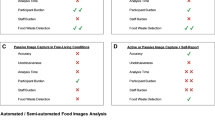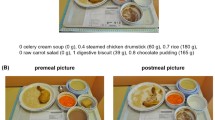Abstract
Introduction
Bariatric operations are effective obesity treatments because of the significant reductions in food intake after surgery, but weight regain remains a problem in a small group of patients after surgery. Estimating food intake is difficult due to dieting status, weight, gender, and challenges with estimating portion size. We aimed to evaluate the use of digital food photography in comparison to conventional methods among patients after sleeve gastrectomy.
Methods
Participants used a mobile device (mHealth) to photo-document their dietary intake of all food and beverages consumed before and after eating. They also completed a 24 h food recall interview with a dietician.
Results
Data from 383 eating occasions were analyzed. Food intake using 24 h recall was reported as 972.5 ± 77 kcal and estimates from photographs were 802.9 ± 63.4 kcal, with a difference of 169.6 ± 451.4 kcal (95% confidence interval (CI) of 41.4 to 297.9 kcal, p = 0.005). There was no difference for protein intake, but carbohydrate intake reported during the 24 h recall was 541.2 ± 298 kcal and estimates from photographs were 395.2 ± 219.6 kcal, with a difference of 145.8 ± 256.3 kcal (95% CI of 73.2 to 218.8 kcal, p = 0.0001).
Conclusion
After sleeve gastrectomy, patients reported eating more total calories and calories from carbohydrates compared to estimations using photographs. The implication for patients are that tools such as mHealth might be useful to optimize food intake and calories after sleeve gastrectomy, especially for those patients that may struggle with weight regain after surgery.
Similar content being viewed by others
References
WHO, W.h.O. Obesity and overweight. 2017 [cited 2018 April 29]; Available from: http://www.who.int/en/news-room/fact-sheets/detail/obesity-and-overweight.
OECD. Obesity Update 2017. 2017;1-14. Available from: https://www.oecd.org/els/healthsystems/Obesity-Update-2017.pdf. Accessed 29 April 2018.
Colquitt JL et al. Surgery for weight loss in adults. Cochrane Database Syst Rev. 2014;(8):1–244.
Picot J, Jones J, Colquitt JL, et al. The clinical effectiveness and cost-effectiveness of bariatric (weight loss) surgery for obesity: a systematic review and economic evaluation. Health Technol Assess. 2009;13(41):1–190.
Macdiarmid J, Blundell J. Assessing dietary intake: who, what and why of under-reporting. Nutr Res Rev. 2007;11(2):231–53.
Carels RA, Konrad K, Harper J. Individual differences in food perceptions and calorie estimation: an examination of dieting status, weight, and gender. Appetite. 2007;49(2):450–8.
Lichtman SW, Pisarska K, Berman ER, et al. Discrepancy between self-reported and actual caloric intake and exercise in obese subjects. N Engl J Med. 1992;327(27):1893–8.
Wansink B, Chandon P. Meal size, not body size, explains errors in estimating the calorie content of meals. Ann Intern Med. 2006;145(5):326–32.
Martin CK, Anton SD, York-Crowe E, et al. Empirical evaluation of the ability to learn a calorie counting system and estimate portion size and food intake. Br J Nutr. 2007;98(2):439–44.
McCambridge J, Witton J, Elbourne DR. Systematic review of the Hawthorne effect: new concepts are needed to study research participation effects. J Clin Epidemiol. 2014;67(3):267–77.
Dahl Lassen A et al. Evaluation of a digital method to assess evening meal intake in a free-living adult population. Food Nutr Res. 2010;54:1–9. https://doi.org/10.3402/fnr.v54i0.5311.
Martin CK et al. A novel method to remotely measure food intake of free-living individuals in real time: the remote food photography method. Br J Nutr. 2008;101(3):446–56.
Wang D-H et al. Validity and reliability of a dietary assessment method: the application of a digital camera with a mobile phone card attachment. J Nutr Sci Vitaminol. 2002;48(6):498–504.
Welch JL, Siek KA, Connelly KH, et al. Merging health literacy with computer technology: self-managing diet and fluid intake among adult hemodialysis patients. Patient Educ Couns. 2010;79(2):192–8.
Matheson DM, Hanson KA, McDonald TE, et al. Validity of children’s food portion estimates: a comparison of 2 measurement aids. Arch Pediatr Adolesc Med. 2002;156(9):867–71.
Koop A, Mösges R. The use of handheld computers in clinical trials. Control Clin Trials. 2002;23(5):469–80.
Lieffers JRL, Hanning RM. Dietary assessment and self-monitoring: with nutrition applications for mobile devices. Can J Diet Pract Res. 2012;73(3):e253–60.
Ptomey LT, Willis EA, Goetz JR, et al. Digital photography improves estimates of dietary intake in adolescents with intellectual and developmental disabilities. Disabil Health J. 2015;8(1):146–50.
Conway JM, Ingwersen LA, Vinyard BT, et al. Effectiveness of the US Department of Agriculture 5-step multiple-pass method in assessing food intake in obese and nonobese women. Am J Clin Nutr. 2003;77(5):1171–8.
USDA. USDA food composition database. 2018 [cited 2018; available from: https://ndb.nal.usda.gov/ndb/search/list.
Beasley J, Riley WT, Jean-Mary J. Accuracy of a PDA-based dietary assessment program. Nutrition. 2005;21(6):672–7.
Heitmann BL, Lissner L. Dietary underreporting by obese individuals—is it specific or non-specific. BMJ. 1995;311:986–9.
Subar AF et al. Using intake biomarkers to evaluate the extent of dietary misreporting in a large sample of adults: The OPEN study. Am J Epidemiol. 2003;158:1–13.
Gemming L, Jiang Y, Swinburn B, et al. Under-reporting remains a key limitation of self-reported dietary intake: an analysis of the 2008/09 New Zealand adult nutrition survey. Eur J Clin Nutr. 2014;68(2):259–64.
Johnson RK, Goran M, Poehlman ET. Correlates of over- and underreporting of energy intake in healthy older men and women. Am J Clin Nutr. 1994;59:1286–90.
Pannemans DL, Westerterp K. Estimation of energy intake to feed subjects at energy balance as verified with doubly labelled water: a study in the elderly. Eur J Clin Nutr. 1993;47:490–6.
Schoeller DA. How accurate is self-reported dietary energy intake? Nutr Rev. 1990;48:373–9.
Schoeller DA, Bandini L, Dietz WH. Inaccuracies in self-reported intake identified by comparison with the doubly labeled water method. Can J Physiol Pharmacol. 1990;68:941–9.
Westerterp KR, V.-v.d. V.W., Meijer GAL, Hoor ten F., Self-reported intake as a measure for energy intake. A validation against doubly labelled water. Obes Eur 1991; 91:17–22.
Freedman, L., et al., Pooled results from 5 validation studies of dietary self-report instruments using recovery biomarkers for energy and protein intake. Vol. 180. 2014.
Wehling H, Lusher J. People with a body mass index ≥ 30 under-report their dietary intake: a systematic review. J Health Psychol. 2017:1359105317714318.
Blake AJ, Guthrie HA, Smiciklas-Wright H. Accuracy of food portion estimation by overweight and normal-weight subjects. J Am Diet Assoc. 1989;89:962–4.
Dixon AFR, Dixon JB, O’Brien PE. Laparoscopic adjustable gastric banding induces prolonged satiety: a randomized blind crossover study. J Clin Endocrinol Metabol. 2005;90(2):813–9.
Coughlin K et al. Preoperative and postoperative assessment of nutrient intakes in patients who have undergone gastric bypass surgery. Arch Surg. 1983;118(7):813–6.
Rosenbaum M et al. Leptin reverses weight loss–induced changes in regional neural activity responses to visual food stimuli. J Clin Invest. 2008;118(7):2583–91.
Stice E, Burger K, Yokum S. Caloric deprivation increases responsivity of attention and reward brain regions to intake, anticipated intake, and images of palatable foods. NeuroImage. 2013;67:322–30.
Miras AD, Jackson RN, Jackson SN, et al. Gastric bypass surgery for obesity decreases the reward value of a sweet-fat stimulus as assessed in a progressive ratio task. Am J Clin Nutr. 2012;96(3):467–73.
Ochner CN, Kwok PY, Conceicao ME, et al. Selective reduction in neural responses to high calorie foods following gastric bypass surgery. Ann Surg. 2011;253(3):502–7.
Bruce AS et al. A comparison of functional brain changes associated with surgical versus behavioral weight loss. Obesity (Silver Spring, Md). 2014;22(2):337–43.
Williamson DA, et al. Digital photography: a new method for estimating food intake in cafeteria settings. Eat Weight Disord. 2004;9:24–8.
Williamson DA, Allen HR, Martin PD, et al. Comparison of digital photography to weighed and visual estimation of portion sizes. J Am Diet Assoc. 2003;103(9):1139–45.
Acknowledgments
We would like to thank all the participants for giving up their time to participate in this study. The authors gratefully acknowledge the clinical service unit at Dasman Diabetes Institute and the Ministory of Health Kuwait.
Author information
Authors and Affiliations
Corresponding author
Ethics declarations
Conflict of Interest
Professor Carel Le Roux received grants from Johnson and Johnson and AnaBio. Also speaker fees from Eli Lilly, Johnson and Johnson, Sanofi Aventis, Astra Zeneca, Janssen, Bristol-Meyers Squibb, p Boehringer-Ingelheim, outside the submitted work. He is on the advisory board of NovoNordisk and GI dynamics. Professor le Roux has nothing to disclose related to this manuscript. All the other authors declare no conflict of interest
Additional information
Publisher’s Note
Springer Nature remains neutral with regard to jurisdictional claims in published maps and institutional affiliations.
Rights and permissions
About this article
Cite this article
Al-Ozairi, E., AlAwadhi, M.M., Al Kandari, J. et al. Photo-Assisted Dietary Method Improves Estimates of Dietary Intake Among People with Sleeve Gastrectomy. OBES SURG 29, 1602–1606 (2019). https://doi.org/10.1007/s11695-019-03736-4
Published:
Issue Date:
DOI: https://doi.org/10.1007/s11695-019-03736-4




